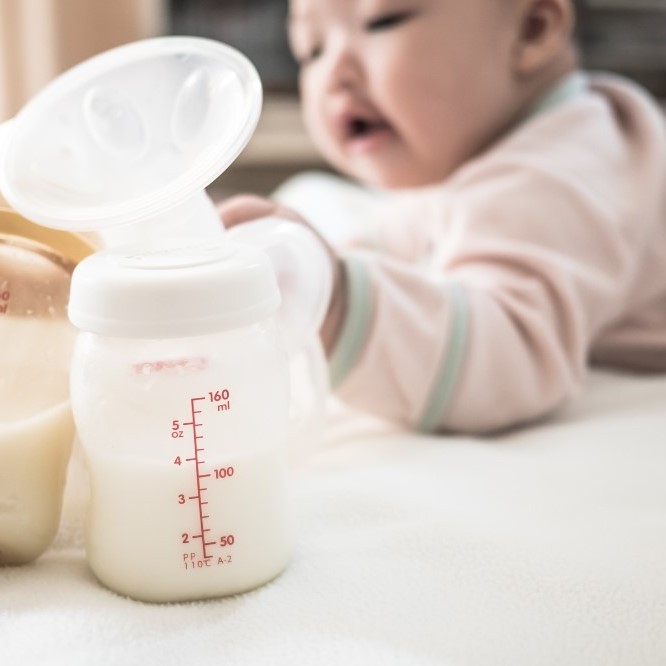The Basics of Mixing Breast Milk and Formula
When you’re combining breast milk with formula, it’s essential to understand the basics. This process, often called combo feeding, requires careful attention to ensure your baby’s health and well-being.
Understand Your Reasons
Start by clearly understanding why you are considering this method. It could be due to supply issues, lifestyle choices, or nutritional needs. Whatever the reason, knowing the ‘why’ helps in planning the ‘how’.
Choose the Right Formula
Next, you need to select a formula that aligns with your infant’s needs. There are various types, from cow’s milk-based to hypoallergenic. Your pediatrician can provide guidance on the best option for your child.
Prepare Separately
Always prepare the breast milk and formula separately. Breast milk should be expressed and stored correctly, while formula must be mixed according to the manufacturer’s instructions.
Mix When Ready to Feed
Only mix the two right before feeding. This ensures the nutrients are fresh and lessens the risk of nutritional degradation or bacterial growth.
Follow Safe Proportions
It’s important to stick to safe proportions when mixing breast milk and formula. Do not dilute formula more than advised, as it can lead to nutritional imbalances.
Maintain Cleanliness
Keeping bottles, nipples, and surfaces clean is crucial in preventing contamination. Always wash your hands before handling breast milk or formula.
By understanding these basics, parents can make informed decisions when mixing breast milk and formula. Remember, every baby is different, so what works for one may not work for another. It’s vital to stay flexible and attentive to your baby’s needs throughout this process.
Reasons Parents Might Combine Breast Milk and Formula

There are several reasons why parents might opt to mix breast milk and formula for their babies. Some of the most common reasons include:
- Supply Issues: Some mothers may not produce enough breast milk to meet their baby’s demands. Mixing formula can supplement the necessary nutrients and calories.
- Return to Work: When mothers go back to work, they may not be able to pump enough breast milk. Formula can be a practical solution for feedings during work hours.
- Health and Diet Concerns: Sometimes, a baby’s health condition or a mother’s diet could require the addition of formula to ensure adequate nutrition.
- Flexibility and Convenience: Parents may find that using formula provides flexibility. It can be convenient, especially when on the go or during times when breast milk is not readily available.
- Personal Choice: Some parents decide to combine feeding methods for personal reasons. These might include the desire for shared feeding responsibilities between parents or simply a preference for combination feeding.
Choosing to combine breast milk and formula is a personal decision and can be based on a variety of individual and family needs. It is important to do so safely following the guidelines mentioned earlier. Consultation with a pediatrician can also provide personalized advice and reassurance.
Types of Formula Suitable for Mixing
When it comes to mixing breast milk and formula, selecting the right type of formula is crucial for your baby’s health and nutrition. Here are the most common types of formula that are suitable for mixing with breast milk:
- Cow’s Milk-Based Formula: This is the most prevalent type and is generally suitable for most infants. When mixed with breast milk, it can provide a balance of necessary nutrients.
- Soy-Based Formula: For babies with lactose intolerance or those on a vegetarian diet, soy-based formula can be an option. Always confirm with your pediatrician before mixing with breast milk.
- Hypoallergenic Formula: If your baby has allergies or sensitivity to certain proteins found in cow’s milk or soy formulas, a hypoallergenic formula can be a safer option to mix with breast milk.
- Specialized Formula: There are formulas available for preterm infants or babies with specific medical conditions. These should only be used under medical advice and can be mixed with breast milk if suitable.
- Organic Formula: For parents looking for an organic option, there are formulas made with organic ingredients. Check the compatibility with breast milk and ensure it meets your infant’s dietary needs.
Choosing the correct formula to mix with breast milk is a decision that should be made with careful consideration and, preferably, with input from your healthcare provider. Understanding each type, its benefits, and when it’s appropriate to use them helps ensure your baby gets the best possible nutrition from both breast milk and formula.
Step-by-Step Guide to Safely Mix Breast Milk and Formula

When it comes to combining breast milk with formula, precision and safety are paramount. Follow this step-by-step guide to ensure you’re providing your baby with a safe mix of nutrients.
- Wash Your Hands: Begin with clean hands to prevent contamination.
- Prepare the Formula: Mix the formula as per the instructions. Do not alter the proportions recommended by the manufacturer.
- Express Breast Milk: If using previously stored breast milk, ensure it is at a safe temperature.
- Combine Just Before Feeding: Mix the prepared formula and breast milk right before your baby’s feeding time.
- Shake Gently: Once combined, shake the bottle gently to mix the contents evenly.
- Check Temperature: Always test the mixture’s temperature to make sure it’s warm, not hot.
- Feed Immediately: Serve the mixture to your baby right away to avoid spoilage.
- Discard Unused Portions: Dispose of any mixture that’s left after a feeding. Do not save it for later.
By following these steps, you’ll create a safe feeding experience for your baby while mixing breast milk and formula. Remember, always consult with a pediatrician if you have doubts or concerns about combo feeding.
Common Myths and Misconceptions About Milk Mixing
In the journey of parenthood, mixing breast milk and formula often spawns myths and misconceptions. These can create needless worry for parents seeking the best for their babies. Here are some common fallacies that need dispelling:
- Myth 1: Mixing Dilutes Nutrients: Some believe that formula dilutes the nutritional value of breast milk. This is not true. Both offer vital nutrients for infant growth.
- Myth 2: It Confuses the Baby’s Digestion: Another myth is that combo feeding confuses a baby’s stomach. In fact, babies adjust well when both are introduced safely.
- Myth 3: Breast Milk Loses Its Benefits: No. Even when mixed, breast milk retains its unique benefits, including antibodies that protect against illness.
- Myth 4: Formula is a ‘Step Down’: Formula is a scientifically-crafted supplement. It’s not inferior but an alternative that ensures infants receive all necessary nutrients.
- Myth 5: You Can’t Go Back to Exclusive Breastfeeding: Many think once formula is introduced, exclusive breastfeeding isn’t possible. Moms can often return to it if they choose and are able.
Recognize these myths for what they are – misconceptions without basis. Mixing breast milk and formula can be part of a complete, balanced diet for your baby. Always consider professional advice and your baby’s health when making feeding decisions. Keep these clarifications in mind when practicing safe mixing techniques highlighted in the previous sections of this blog.
Nutritional Considerations When Mixing Breast Milk and Formula

When mixing breast milk and formula, it’s vital to consider the nutritional impact on your baby. Let’s dive into the factors that ensure your baby gets balanced nutrition from both sources.
- Maintain Nutrient Balance: Breast milk provides a perfect blend of nutrients tailored by nature for your baby. Formula is designed to mimic this balance. When mixing, stick to proper proportions as recommended to maintain this delicate nutrient balance.
- Monitor Growth and Development: Tracking your baby’s growth can guide the combo feeding process. Regular check-ups with the pediatrician help ensure the nutritional mix supports proper development.
- Adjust as Needed: Babies’ nutritional needs change as they grow. Be ready to adjust the ratio of breast milk to formula based on their developmental stages and dietary requirements.
- Consider Special Nutritional Needs: Some infants may have unique health needs that influence their diet. For instance, premature babies might require more protein. Always consult with a healthcare professional when dealing with such special circumstances.
- Beware of Overfeeding: When mixing breast milk and formula, it’s easy to overfeed as formula may be denser in calories. Pay attention to your baby’s hunger cues to avoid overfeeding.
- Iron Supplementation: Breast milk is low in iron, so formulas are often iron-fortified. When mixing, make sure not to exceed the necessary iron levels, especially for infants older than 6 months.
By keeping these nutritional considerations top of mind when mixing breast milk and formula, you can support your baby’s health and growth effectively. Remember to consult your pediatrician for personalized advice tailored to your baby’s specific needs.
Tips for Storage and Handling Mixed Feeds
When you are mixing breast milk and formula, storing and handling the feeds properly is key. Here are some tips:
- Keep it Cool: Store breast milk in the fridge right after expressing it. For mixed feeds, use them quickly or store them in the fridge too.
- Short Shelf Life: Mixed feeds should be used within 24 hours if refrigerated. Never keep them at room temperature for more than an hour.
- Warm Carefully: Warm the mixture by placing the bottle in warm water. Do not use a microwave as it can cause hot spots.
- Single Use Only: Once your baby starts feeding, use the mix within one hour. Do not save leftovers for later to avoid bacteria.
- Clean Bottles: Wash all feeding equipment in hot, soapy water. Rinse well. Sterilize them if your baby is under three months old, was born prematurely, or has a weak immune system.
- Label Everything: Mark bottles with the date and time of preparation. This helps track freshness and prevents mix-ups.
By following these tips, you can ensure that mixed feeds are safe and nutrient-rich for your baby. Remember, when in doubt, it’s safer to prepare a fresh mix rather than risk any contamination.
When to Consult a Healthcare Provider
While mixing breast milk and formula can be done safely, there are certain times when consulting a healthcare provider is crucial. Paying attention to your baby’s reaction to the mixed feedings is important. If you observe any unusual symptoms or behaviors, it’s time to get professional advice. Here’s when you should reach out to a healthcare provider:
- When Starting Combo Feeding: Before you begin mixing breast milk and formula, consult your pediatrician. They can provide guidelines specific to your baby’s health and nutritional needs.
- If Your Baby Has Allergies: If there is a history of allergies or food intolerances in your family, discuss this with your doctor. They can recommend a hypoallergenic formula to mix with breast milk.
- When Your Baby Shows Discomfort: If your baby is fussy, gassy, or shows signs of discomfort after feedings, it may be a reaction to the formula. Your doctor can help identify the issue and suggest changes.
- In Case of Poor Weight Gain: Should your baby not gain weight steadily, a healthcare provider can assess whether the mix of breast milk and formula is meeting your baby’s nutritional requirements.
- For Special Dietary Needs: Babies with specific health conditions might need custom feeding plans. For example, premature infants may need formula with more calories or nutrients.
- Before Making Any Changes: If you want to adjust the ratio of breast milk to formula, or switch formulas, talk to your pediatrician first. They can ensure the transition is smooth and beneficial.
Always remember, your baby’s health and safety come first. Regular check-ups and conversations with your healthcare provider can help navigate the process of mixing breast milk and formula effectively and safely.
